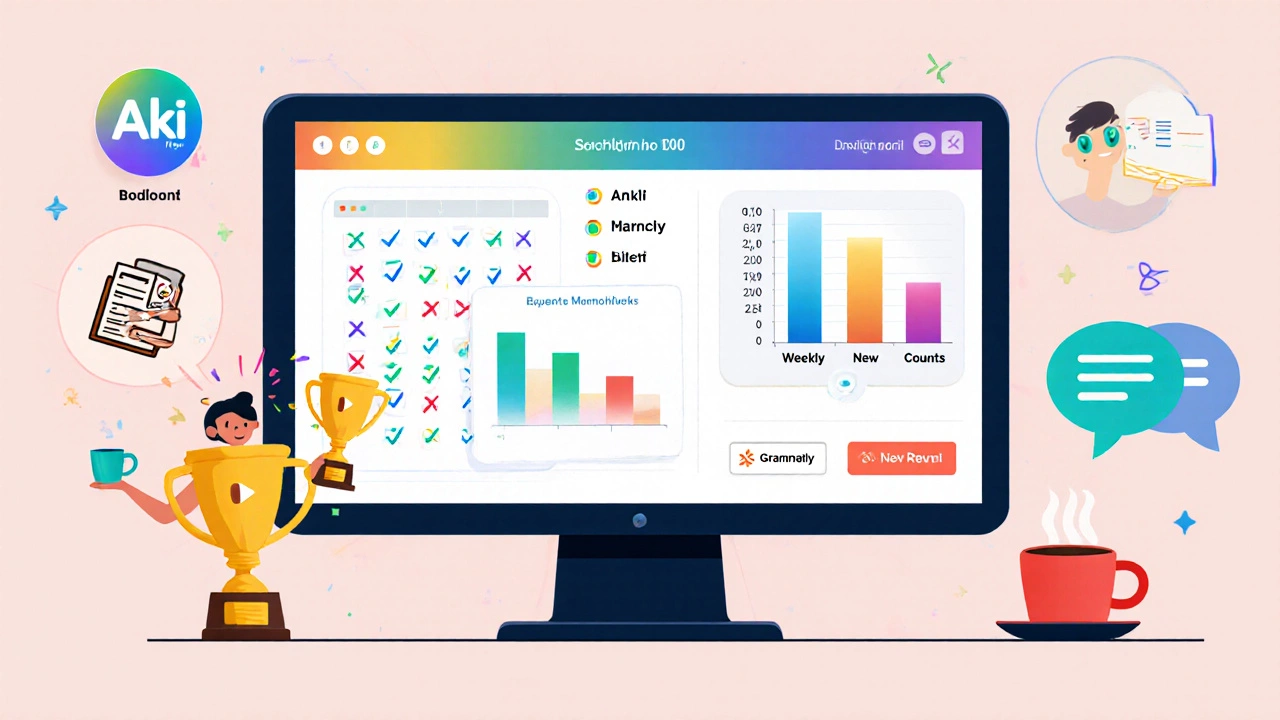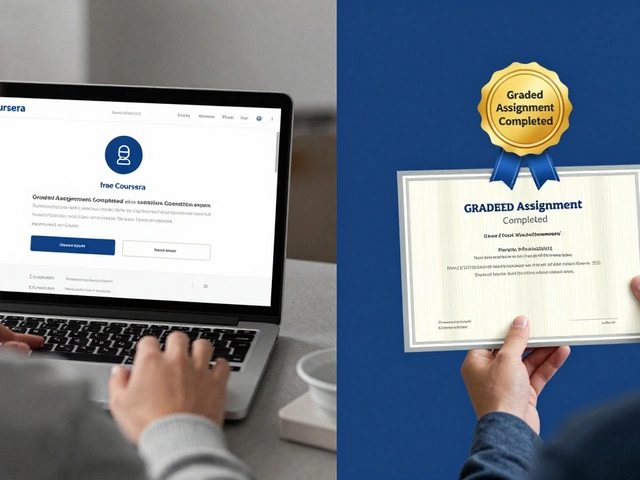English Fluency Progress Tracker
Track your path to English fluency with this personalized progress calculator. Based on your current level, target goal, and weekly study time, we'll estimate how long it will take you to reach your fluency milestone.
Your Progress Estimate
Estimated time to reach your goal:
Based on 10-12 hours weekly of active study as recommended in the article.
English fluency is the ability to speak, understand, read, and write English confidently and naturally. Many people wonder if they can reach that level without stepping into a classroom. The short answer is yes - but only if you treat self‑learning like a structured course. Below you’ll find a step‑by‑step roadmap, real‑world tools, and common pitfalls to avoid, so you can decide whether going solo fits your schedule, budget, and learning style.
Why Self‑Study Can Work
When you design your own program, you control four key variables: exposure, output, feedback, and motivation. Exposure means the amount of English you absorb each day - podcasts, news articles, movies, or YouTube channels. Output is the speaking or writing you produce, which forces your brain to retrieve vocabulary and grammar. Feedback comes from native speakers, language‑exchange apps, or automated tools that point out mistakes. Finally, motivation is the personal reason behind every study session, whether it’s a career boost, travel plan, or simply the joy of mastering a new skill.
Studies from the British Council (2023) show that learners who combine daily exposure with at least 30 minutes of active production improve speaking scores faster than those who rely only on passive listening. In short, self‑study works when you balance all four pillars.
Designing a Personal Curriculum
- Set a concrete fluency goal. For most adults, CEFR B2 (upper‑intermediate) is enough for work and travel; C1 is the threshold for academic or professional writing.
- Break the goal into quarterly milestones - e.g., “Complete 500 new words” or “Hold a 10‑minute conversation without pauses”.
- Allocate time blocks: 15 minutes listening, 20 minutes reading, 15 minutes speaking, 10 minutes writing.
- Choose resources that align with each block (see the resource table below).
- Review progress weekly and adjust the schedule.
Keeping a simple spreadsheet or a free habit‑tracker app helps you see gaps before they become habits.
Core Resources for Solo Learners
| Skill | Self‑Study Tool | Typical Classroom Alternative |
|---|---|---|
| Listening | BBC Learning English podcasts | Audio‑lab sessions |
| Reading | News in Levels | Textbook passages |
| Speaking | italki language‑exchange | In‑class conversation drills |
| Writing | Grammarly free version | Essay assignments |
| Vocabulary | Anki spaced‑repetition decks | Word‑list memorisation |
All the tools listed above are free or low‑cost, making self‑study financially viable.
Immersion Without Moving Abroad
True immersion means surrounding yourself with English 24/7. You don’t need to relocate; you can create an English‑only bubble at home:
- Change phone, computer, and social‑media language settings to English.
- Watch one TV series with subtitles in English for 30 minutes daily.
- Read news articles aloud - the act of vocalising improves pronunciation.
- Join a local meetup or a virtual language exchange group on platforms like Meetup.com.
These habits turn passive time (commuting, cooking) into active practice.

Pronunciation and Accent Reduction
Even fluent speakers stumble over tricky sounds. Targeted practice beats luck:
- Identify the three sounds that differ most from your native language - e.g., the “th” in “think” and “this”, the vowel in “cat”, and the flap “r”.
- Use YouGlish to hear thousands of examples in context.
- Record yourself repeating short sentences, then compare waveforms with native speakers using free audio editors like Audacity.
- Spend 5 minutes daily on minimal‑pair drills (e.g., “ship/sheep”).
Consistency beats volume - five minutes every day yields more retention than an hour once a week.
Tracking Progress and Staying Motivated
Motivation wanes if you can’t see improvement. Adopt two simple metrics:
- Self-study English - log the number of new words mastered each week (aim for 30‑50).
- Speaking fluency - record a 2‑minute monologue every month, then evaluate speed, filler words, and clarity.
When the numbers climb, reward yourself with a small treat: a favorite movie or a coffee out.
When to Consider a Formal Course
Self‑study works for most, but some signs indicate it’s time to enlist a teacher:
- Plateaus after six months despite steady practice.
- Consistent errors in grammar that you can’t self‑correct.
- Professional or academic deadlines requiring certified proficiency (e.g., IELTS, TOEFL).
Hybrid models-one‑on‑one tutoring a few times a month combined with solo work-often deliver the best of both worlds.

Common Pitfalls and How to Avoid Them
| Pitfall | Why It Happens | Fix |
|---|---|---|
| Skipping speaking | Fear of making mistakes | Start with short shadow‑reading, then graduate to language‑exchange. |
| Only consuming passive content | Convenient but not productive | Pair each video with a summary note or a spoken retell. |
| Using too many apps | “More is better” mindset | Pick three core tools and master them before adding another. |
| Neglecting feedback | Assuming self‑correction is enough | Get weekly corrections from a native tutor or use speech‑analysis software. |
Quick Checklist Before You Start
- Define your fluency level (B2, C1, etc.).
- Schedule daily 60‑minute blocks covering all four skills.
- Choose one resource per skill from the table above.
- Set up a tracking sheet for words, speaking minutes, and weekly reflections.
- Find a language‑exchange partner for at least one conversation per week.
Mini FAQ
Can I reach native‑like pronunciation on my own?
Yes, but it needs focused drills, frequent listening, and regular recording. Tools like YouGlish and Audacity let you compare your sound to native speakers and correct tiny mismatches.
How many hours per week are realistic for self‑study?
For steady progress, aim for 10‑12 hours weekly. Split them into short, focused sessions (15‑30 minutes) to keep concentration high.
Is it worth paying for an online course if I’m self‑motivated?
If you’re disciplined, free resources can suffice. However, a paid course adds structured feedback, a clear syllabus, and a community, which can shorten the path to fluency.
What’s the best way to expand my vocabulary quickly?
Use spaced‑repetition apps like Anki, but link each word to a personal sentence or image. Contextual use beats rote memorisation.
How do I stay motivated during plateaus?
Change the routine - swap a podcast for a movie, try a new conversation partner, or set a micro‑goal like “order food in English without looking at the menu”. Fresh challenges reignite interest.
With a clear plan, the right tools, and consistent effort, you can achieve English fluency without ever stepping into a classroom. The journey is personal, but the milestones are universal - and every step you take brings you closer to speaking like a native.




